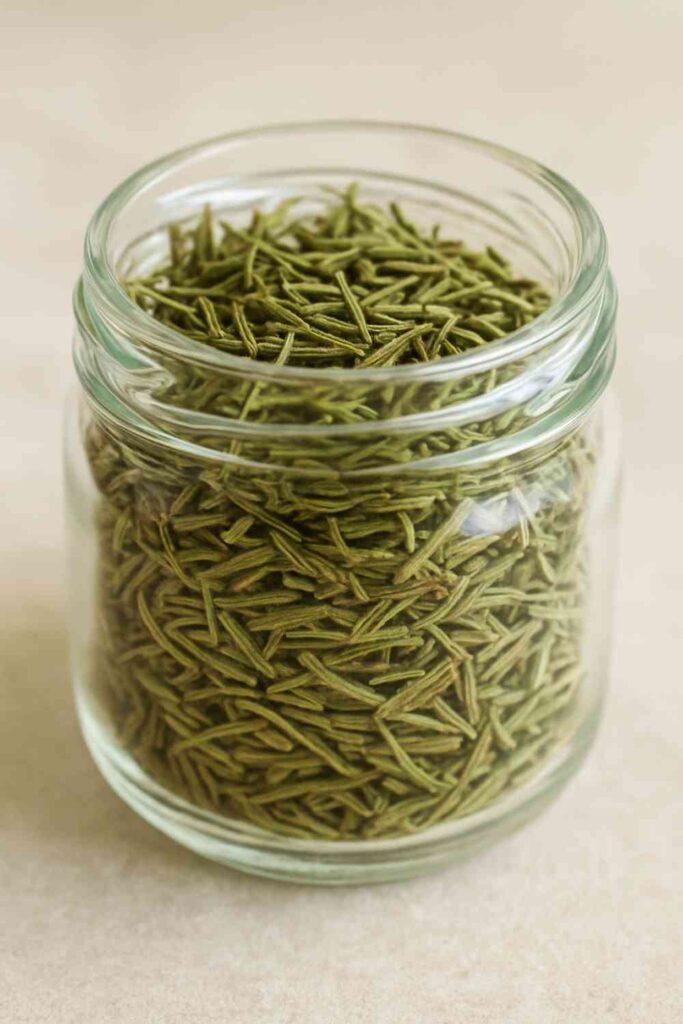Rosemary is one of the most versatile and resilient herbs you can grow at home. With its needle-like leaves and woody stems, this Mediterranean native has earned a permanent spot in kitchens and gardens around the world.
Its piney fragrance and earthy, slightly minty flavor complement everything from roasted potatoes and bread to marinades, soups, and even teas.
But here’s the catch: if you grow rosemary, you’ll often find yourself with more sprigs than you can use fresh. And while the plant is hardy, it won’t survive in freezing conditions outdoors. That’s why drying rosemary is one of the best ways to preserve its flavor for months, ensuring you can enjoy that fragrant touch in your cooking all year long.
Unlike delicate herbs such as basil or cilantro, rosemary is tough—it holds onto its essential oils and flavor even after drying. The key is choosing the right method for your climate, kitchen setup, and how quickly you want results.
Harvesting Rosemary
Drying rosemary starts long before you hang it up or pop it into the oven—it begins with the harvest. If you harvest at the right time and in the right way, you’ll lock in maximum flavor.
When to Harvest?
- The best time is just before the plant flowers, when essential oils are at their peak.
- Harvest in the morning, after dew has dried but before the sun gets strong. This is when oils are most concentrated.
How to Harvest?
- Use sharp scissors or pruning shears to cut 6–8 inch sprigs.
- Always cut just above a leaf node. This not only gives you sprigs to dry but also encourages bushier growth.
- Don’t take more than one-third of the plant at a time—your rosemary will stay healthier and continue producing.
How to Dry Rosemary Leaves?

If your rosemary sprigs have a bit of dust on them, give them a quick rinse, but don’t let them soak in water. Gently pat them dry with a towel and leave them to air dry fully—any lingering moisture can cause mold as they dry.
Once the sprigs are completely dry, you’re ready to start the process. There are four easy methods you can use—air-drying, oven-drying, dehydrator-drying, or microwave-drying—so you can pick the one that fits your time and tools best.
Also Read: How to Dry Fresh Basil Naturally?
Method 1: Air-Drying Method
This is the most traditional way to dry rosemary, relying on natural air circulation instead of artificial heat. It’s simple, cost-free, and helps the herb retain much of its natural aroma and oils.
By bundling sprigs together and hanging them upside down in a dry, ventilated space, rosemary gradually loses its moisture while keeping its earthy, pine-like fragrance intact.
- Gather 6–8 rosemary sprigs and tie them together with string or a rubber band.
- Hang the bundles upside down in a warm, dry, well-ventilated area out of direct sunlight (such as a pantry, attic, or unused room).
- To keep dust away, cover the bundles loosely with a paper bag punched with small holes.
- Allow the rosemary to dry for 10–14 days, depending on humidity. It’s ready when the leaves are crisp and crumble easily.
Method: 2 Oven-Drying Method
Oven-drying is a quick and practical way to dry rosemary, especially if you live in a humid area where air-drying may not work well. Using gentle heat, this method removes moisture faster while still preserving most of the herb’s flavor and aroma.
By spreading sprigs in a single layer and drying them slowly at low temperatures, you can have crisp rosemary ready to store within just a couple of hours.
- Preheat your oven to the lowest setting, ideally between 170–200°F (75–95°C).
- Arrange rosemary sprigs in a single layer on a baking sheet lined with parchment paper.
- Keep the oven door slightly ajar to allow moisture to escape during drying.
- Check the rosemary every 20 minutes; drying usually takes 1–2 hours.
- The rosemary is ready when the leaves are brittle and crumble easily once cooled.
Method: 3 Dehydrator-Drying Method
Using a food dehydrator is one of the most reliable ways to dry rosemary, especially if you regularly preserve herbs. This method ensures steady airflow and controlled temperature, which helps retain the herb’s essential oils and flavor with minimal effort.
By laying the sprigs in a single layer and letting the dehydrator do its work, you’ll have perfectly dried rosemary in just a few hours.
- Wash rosemary sprigs lightly if needed, then pat them completely dry.
- Arrange the sprigs in a single layer on dehydrator trays, leaving space for air circulation.
- Set the dehydrator to a low temperature, ideally between 95–115°F (35–46°C).
- Dry for 2–4 hours, checking periodically.
- The rosemary is ready when the leaves are crisp and crumble easily between your fingers.
Method: 4 Microwave-Drying Method
If you’re looking for the fastest way to dry rosemary, the microwave method is your go-to. It’s especially handy when you only need a small batch and don’t want to wait hours or days. While not as gentle as air-drying or dehydrating, it still preserves much of the herb’s flavor and aroma.
By microwaving short bursts at low power, the rosemary quickly loses moisture without burning.
- Rinse the rosemary lightly if needed and pat completely dry with a towel.
- Spread 2–3 sprigs in a single layer between two sheets of paper towel.
- Microwave on low power for 30 seconds at a time.
- Check after each interval and repeat until the leaves are dry and brittle (usually 1–3 minutes total).
- Let them cool before storing to ensure no residual moisture remains.
How to Store Dried Rosemary?

Storing dried rosemary the right way helps preserve its natural oils, aroma, and flavor for as long as possible. Once the sprigs are fully dry, a few simple steps will ensure your herb stays fresh and potent in your kitchen.
Also Read: How to Dry Fresh Lavender From Your Garden?
Tips for Storing Dried Rosemary

- Strip the leaves from stems: Remove the brittle leaves from their woody stems once dry. For best flavor, keep them whole and only crumble when cooking, as whole leaves retain oils longer.
- Choose the right container: Store rosemary in airtight glass jars, metal tins, or food-safe plastic containers with tight lids. Avoid paper bags or loosely sealed jars that let air and moisture in.
- Protect from light: If possible, use dark-colored glass jars to shield the leaves from light, which can fade both aroma and strength.
- Pick the right location: Keep containers in a cool, dry place like a pantry or cabinet, away from direct sunlight, stoves, or dishwashers. Heat and humidity quickly degrade dried herbs.
- Know its shelf life: Rosemary keeps its best flavor for about a year, though it can last longer. Always do a quick sniff test before using.
- Label and date: Mark the jars with the harvest or drying date to track freshness and know when to replace your supply.
With these simple steps, your dried rosemary will stay fragrant and ready to flavor your roasted vegetables, stews, and breads long after the growing season ends.
How to Use Dried Rosemary?
Dried rosemary is a kitchen staple that brings bold, earthy flavor to countless dishes. Even though it’s stronger than fresh rosemary, it’s easy to use once you know how to balance it. From savory mains to homemade seasonings, here are some of the best ways to enjoy your dried rosemary.
- Cooking: Add to roasted potatoes, chicken, lamb, fish, or vegetables. A pinch also elevates soups, sauces, and bread dough. Since dried rosemary is more concentrated than fresh, use about one-third the amount.
- Seasoning blends: Mix with oregano, thyme, garlic powder, and chili flakes for Mediterranean or Italian-style herb blends. Perfect for pasta, marinades, and meat rubs.
- Herbal tea: Steep 1 teaspoon of dried rosemary in hot water for 5–7 minutes. Optional: add lemon or honey for a soothing, digestive-friendly tea.
- Infused oils & butters: Blend rosemary into olive oil and let it steep for a week to create aromatic drizzle for bread or salads. Or mix into softened butter with garlic for a flavorful spread.
- Homemade crafts: Beyond the kitchen, dried rosemary can be used in potpourri, bath salts, or sachets for a refreshing herbal aroma.
With just a few sprinkles, dried rosemary can transform simple meals into fragrant, flavorful dishes—making it one of the most versatile herbs you can keep in your pantry.
Final Thoughts
Drying rosemary is simple, and the method you choose really depends on your needs. If you enjoy traditional gardening practices, air-drying is the gentlest option. For quicker results, the oven or microwave can get the job done, while a dehydrator is perfect if you often preserve herbs and want consistent, reliable results.
No matter which method you go for, having a jar of dried rosemary in your pantry means you’ll always have that earthy, piney flavor ready to enhance your cooking—even when your garden is resting through the winter.

Khaja Moinuddin, a computer science graduate, finds joy in gardening and homesteading. Join him on this blog as he shares his experiences in homesteading, gardening, and composting